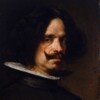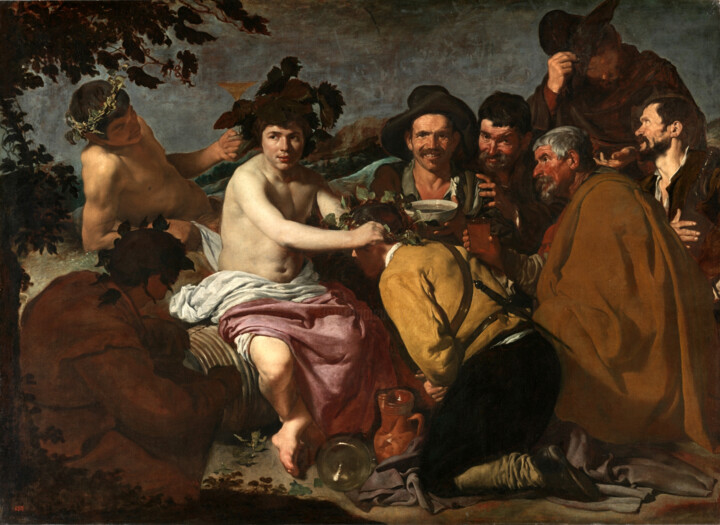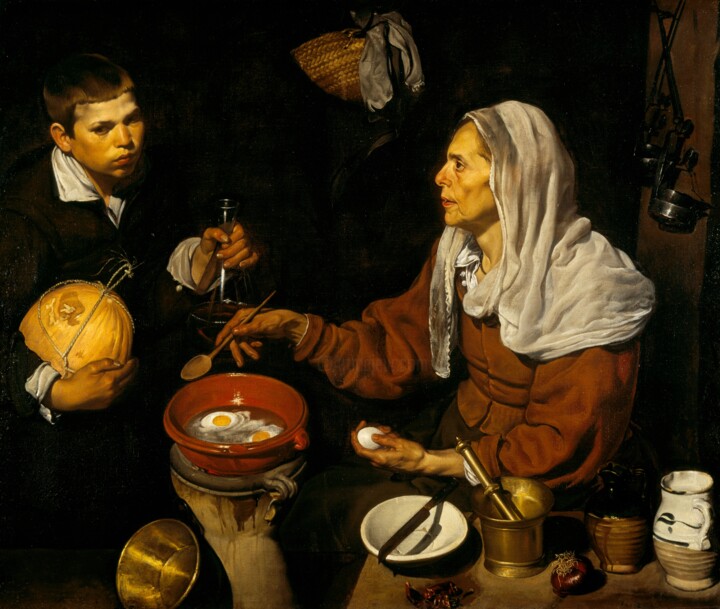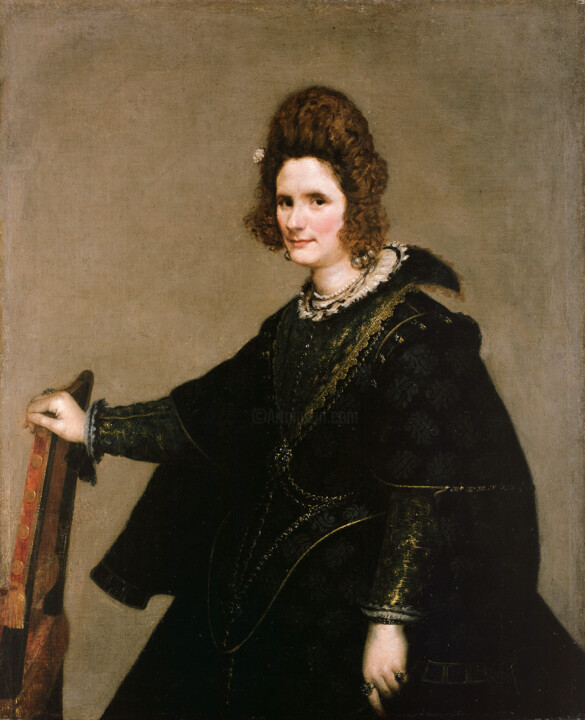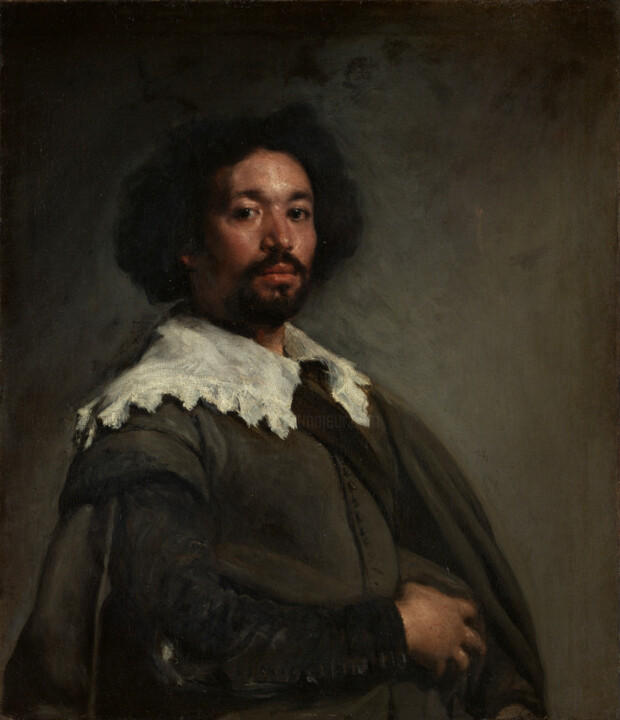 Diego Velázquez, Self-portrait, c. 1645. Oil on canvas, 1 035 x 825 mm. Florence: Uffizi Gallery.
Diego Velázquez, Self-portrait, c. 1645. Oil on canvas, 1 035 x 825 mm. Florence: Uffizi Gallery.
Who was Diego Velázquez?
Diego Velázquez was a Spanish painter who lived from 1599 to 1660. He is considered one of the greatest painters in the history of Western art and is best known for his portraits of the Spanish royal family, members of the court, and other notable figures of his time. Velázquez began his career as an apprentice in Seville, Spain, before moving to Madrid in 1622, where he became the court painter to King Philip IV. He produced numerous paintings for the king, including portraits, historical scenes, and mythological subjects. Velázquez's style was characterized by his use of light and shadow, his ability to capture the essence of his subjects, and his attention to detail. He was also a master of color and composition, creating complex compositions that drew the viewer into the painting. Some of Velázquez's most famous works include "Las Meninas," "The Surrender of Breda," and "The Rokeby Venus." His influence on art has been significant, with artists such as Édouard Manet and Pablo Picasso citing him as an inspiration.
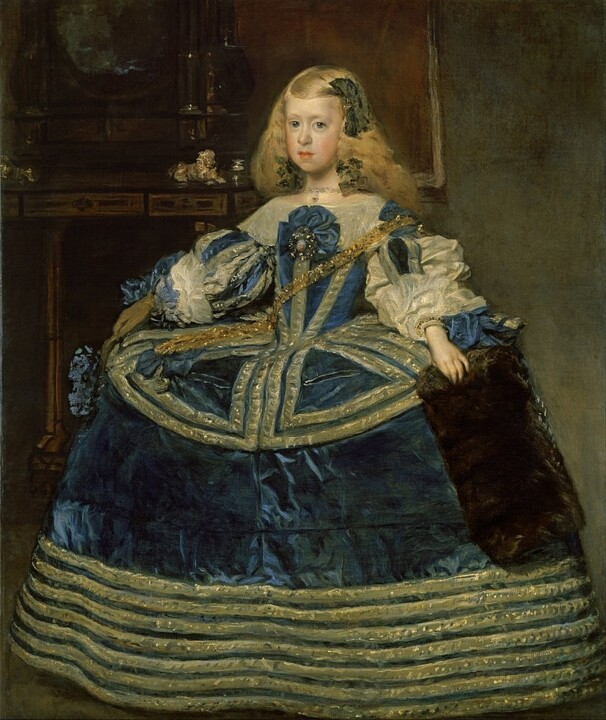 Diego Velázquez, The Infanta Margarita in Blue, 1659. Oil on canvas, 127×107 cm. Vienna: Kunsthistorisches Museum.
Diego Velázquez, The Infanta Margarita in Blue, 1659. Oil on canvas, 127×107 cm. Vienna: Kunsthistorisches Museum.
What are five key points about Diego Velázquez?
Diego Velázquez (1599-1660) was a Spanish painter who is widely considered one of the most important artists of the Baroque period. Here are five key points about his life and work:
- Velázquez was born in Seville, Spain and showed an early aptitude for art. He trained under Francisco Pacheco, a local painter, and later traveled to Madrid where he painted portraits for the Spanish court.
- Velázquez is perhaps best known for his portraits, which are characterized by their realistic and sympathetic portrayal of the subject. His most famous work is "Las Meninas," a painting of the Spanish princess Margarita surrounded by her attendants and courtiers.
- In addition to his portraits, Velázquez also painted historical and mythological scenes. His works often featured rich colors, dramatic lighting, and a sense of depth and atmosphere.
- Velázquez was highly respected during his lifetime and was appointed court painter by King Philip IV of Spain. He also served as curator of the royal art collection and was involved in the decoration of the royal palace.
- Velázquez's influence can be seen in the work of later artists, including Francisco de Goya and Édouard Manet. His innovative approach to composition, use of light and shadow, and realistic depictions of people and scenes continue to inspire artists today.
What are the most famous works of Diego Velázquez?
 Diego Velázquez, Las Meninas, c. 1656. Oil on canvas, 318×276 cm. Madrid: Museo del Prado.
Diego Velázquez, Las Meninas, c. 1656. Oil on canvas, 318×276 cm. Madrid: Museo del Prado.
- Las Meninas, 1656: the scene shows the infanta Margarita and her meninas María Agustina Sarmiento and Isabel de Velasco. In the background, you can see King Philip IV and his second wife, Queen Maria of Austria. In the picture, Velázquez himself is shown at work.
 Diego Velázquez, The Waterseller of Seville, 1618–1622. Oil on canvas, 105 cm × 80 cm. London: Apsley House.
Diego Velázquez, The Waterseller of Seville, 1618–1622. Oil on canvas, 105 cm × 80 cm. London: Apsley House.
- Seville's Water Bearer, 1618–1620: The picture is a metaphor for the three stages of a person's life. An old man, the water-bearer, gives a young man a glass of water, which represents the passing on of knowledge. In the background, another man looks at the scene.
 Diego Velázquez, Venus Rokeby, c. 1648. Oil on canvas, 122.5×175 cm. London: National Gallery.
Diego Velázquez, Venus Rokeby, c. 1648. Oil on canvas, 122.5×175 cm. London: National Gallery.
- Venus Rokeby, 1648–1651: Venus is lying on a bed and looking at herself in the mirror that Cupid is holding up. But the goddess's image is blurry. Velázquez may have done this to make sure that the goddess didn't look like a real person.
 Diego Velázquez, Christ Crucified, 1632. Oil on canvas, 249 cm × 170 cm. Madrid: Museo del Prado.
Diego Velázquez, Christ Crucified, 1632. Oil on canvas, 249 cm × 170 cm. Madrid: Museo del Prado.
- Christ Crucified, 1632: The crucifix stands out against the dark background, which makes it an image of universal value that goes beyond place and time.
 Diego Velázquez, Equestrian Portrait of the Count-Duke of Olivares, c. 1636. Oil on canvas, 313 × 239 cm. Madrid: Museo del Prado.
Diego Velázquez, Equestrian Portrait of the Count-Duke of Olivares, c. 1636. Oil on canvas, 313 × 239 cm. Madrid: Museo del Prado.
- Portrait of the Count-Duke of Olivares on a Horse, 1636: Several parts of the painting, like the half-armor, the general's band, and the hat, show how important and grand Gaspar de Guzmán, also known as the Count-Duke of Olivares, is.
 Diego Velázquez, Old woman frying eggs, 1618. Oil on canvas, 100.5×119.59 cm. Edinburgh: National Gallery of Scotland.
Diego Velázquez, Old woman frying eggs, 1618. Oil on canvas, 100.5×119.59 cm. Edinburgh: National Gallery of Scotland.
Early years
Diego Velázquez was born in Seville, Spain in 1599. His early years are shrouded in mystery, and not much is known about his private life during this time. However, it is believed that he was born into a middle-class family, and his father was a notary. Velázquez showed an early interest in art and was trained in the studio of Francisco Pacheco, a prominent painter and art theorist in Seville. Pacheco was not only Velázquez's teacher but also his father-in-law. In 1618, Velázquez married Pacheco's daughter, Juana, and the couple had two daughters together. It is believed that Velázquez spent his early years in Seville, honing his craft and working on commissioned pieces. His first significant work, "Adoration of the Magi," was completed in 1619 when he was just 20 years old. The painting was well-received and led to more commissions for Velázquez. In 1622, Velázquez moved to Madrid at the request of King Philip IV, who had seen his work and was impressed by his talent. Velázquez became the official court painter and was responsible for creating portraits of the royal family and other members of the court. His portraits were highly realistic and showed a great attention to detail, making him one of the most sought-after painters of his time. Despite his success, Velázquez remained a private and reserved individual, with little known about his personal life. He continued to work for the royal family for many years, producing some of his most famous works, including "Las Meninas," which is considered one of the greatest paintings of all time.
What are the most important works from Diego Velázquez's Sevillano period?
 Diego Velázquez, The Adoration of the Magi, 1619. Oil on canvas, 204 cm × 126.5 cm. Madrid: Museo del Prado.
Diego Velázquez, The Adoration of the Magi, 1619. Oil on canvas, 204 cm × 126.5 cm. Madrid: Museo del Prado.
- "Adoration of the Magi" (1619): This painting, which depicts the biblical story of the Three Wise Men, showcases Velázquez's talent for capturing human expression and emotion.
 Diego Velázquez, Christ in the House of Martha and Mary, 1618. Oil on canvas, 63 cm × 103.5 cm. London: National Gallery.
Diego Velázquez, Christ in the House of Martha and Mary, 1618. Oil on canvas, 63 cm × 103.5 cm. London: National Gallery.
- "Christ in the House of Martha and Mary" (1620): In this painting, Velázquez depicts a scene from the New Testament in which Jesus visits the home of Martha and Mary. The work showcases his skill at portraying light and shadow, as well as his ability to capture the details of everyday life.
- "The Water Seller of Seville" (1620): This painting depicts a street vendor selling water, and is notable for its realistic depiction of the figure and its use of light and shadow.
 Diego Velázquez, Portrait of the Infante Philip Prospero, 1659. Oil on canvas, 128.5×99.5 cm. Vienna: Kunsthistorisches Museum.
Diego Velázquez, Portrait of the Infante Philip Prospero, 1659. Oil on canvas, 128.5×99.5 cm. Vienna: Kunsthistorisches Museum.
Madrid (1622 -1629)
During the Madrid period from 1622 to 1629, Velázquez served as a court painter for King Philip IV of Spain. This was a significant period in his career, as it allowed him to gain access to the highest levels of Spanish society and to develop his artistic style. During this period, Velázquez painted several portraits of the royal family, including King Philip IV and his wife, Queen Isabella. He also painted a number of other notable figures from Spanish society, including members of the clergy, courtiers, and other dignitaries.
 Diego Velázquez, Triumph of Bacchus, 1628-1629. Oil on canvas, 165.5×227.5 cm. Madrid: Museo del Prado.
Diego Velázquez, Triumph of Bacchus, 1628-1629. Oil on canvas, 165.5×227.5 cm. Madrid: Museo del Prado.
Work of those years: The Triumph of Bacchus
"The Triumph of Bacchus" (or "Los Borrachos") is a famous painting created by the Spanish painter Diego Velázquez in 1628. The painting depicts the god of wine, Bacchus, surrounded by a group of drunken men who have indulged in wine and revelry. The painting is significant for its portrayal of the men, who are depicted in a realistic and unidealized manner, unlike the conventional portrayal of mythological figures. The use of light and shadow in the painting creates a sense of depth and three-dimensionality, making the figures appear almost lifelike. The painting is housed at the Museo del Prado in Madrid and is considered one of Velázquez's masterpieces, showcasing his skill in capturing human emotions and expressions.
 Diego Velázquez, Juan de Pareja, 1650. Oil on canvas, 81.3 x 69.9 cm. New York: Met.
Diego Velázquez, Juan de Pareja, 1650. Oil on canvas, 81.3 x 69.9 cm. New York: Met.
An year an half in Italy
In 1629, Velázquez got permission to go to Italy for a year and a half. Even though this first trip was important for the development of his style and for the history of Spanish royal patronage (because Philip IV paid for it), not much is known about what the painter saw, who he met, how he was seen, or what changes he wanted to make to his style. He went to Venice, Ferrara, Cento, Loreto, Bologna, and Rome. In 1630, he went to Naples to make a portrait of Maria Anna of Spain. It is likely that he met Ribera there. Joseph's Bloody Coat brought to Jacob (1629–30) and Apollo in the Forge of Vulcan (1630) are the most important works from his first time in Italy. Both show that he wanted to be a great history painter like the Italians. The bible scene, which shows a deception, and the mythological scene, which shows the truth about a deception, are both made up of several nearly life-sized figures and are about the same size. They may have been meant to be pendants. As he did in The Triumph of Bacchus, Velázquez made his figures look like they were living in the present day. Their movements and expressions were like those of regular people. Velázquez followed the lead of Bolognese painters like Guido Reni and painted Apollo in the Forge of Vulcan on a light gray ground instead of the dark reddish ground he had used in all of his early works. The change made his paintings brighter than they had been before, and he started to use light-gray bases all the time. Velázquez returned to Madrid in January 1631, always working in the service of the Spanish court.
 Diego Velázquez, Dwarf with dog, 1640-1645. Oil on canvas, 142×107 cm. Madrid: Museo del Prado.
Diego Velázquez, Dwarf with dog, 1640-1645. Oil on canvas, 142×107 cm. Madrid: Museo del Prado.
The second trip to Italy and the portrait of the pope
In 1649, Velázquez left Malaga and sailed to Genoa. From there, he went to Milan and then Venice, where he slowly bought works by Titian, Tintoretto, and Veronese. These paintings mark the beginning of Velázquez's third and last style, which can be seen in the large picture of Pope Innocent X in the Doria Pamphilj Gallery in Rome, where Velázquez went next. There, the Pope treated him very well and gave him an award and a gold chain. Sir Joshua Reynolds said that the picture was the most beautiful painting in Rome. Velázquez took a copy of it with him to Spain. Speaking of the masterpiece, Diego Velázquez's portrait of Pope Innocent X is a famous painting made in 1650. The portrait is remarkable for its realistic depiction of the pope, with incredible attention to detail in facial features and clothing. Velázquez was a master of the Baroque period, known for his ability to capture the personality of his subjects in portraits. In this painting, the artist portrays the pope as a powerful figure with a stern expression and piercing gaze.
The last years
Beginning in February 1650, Philip asked Velázquez over and over again to go back to Spain. So, Velázquez went back to Spain, where the king gave him the high position of aposentador mayor. This job required him to take care of the rooms where the court lived, which kept him from working on his art. The pieces he made during this time are some of the best examples of his style.

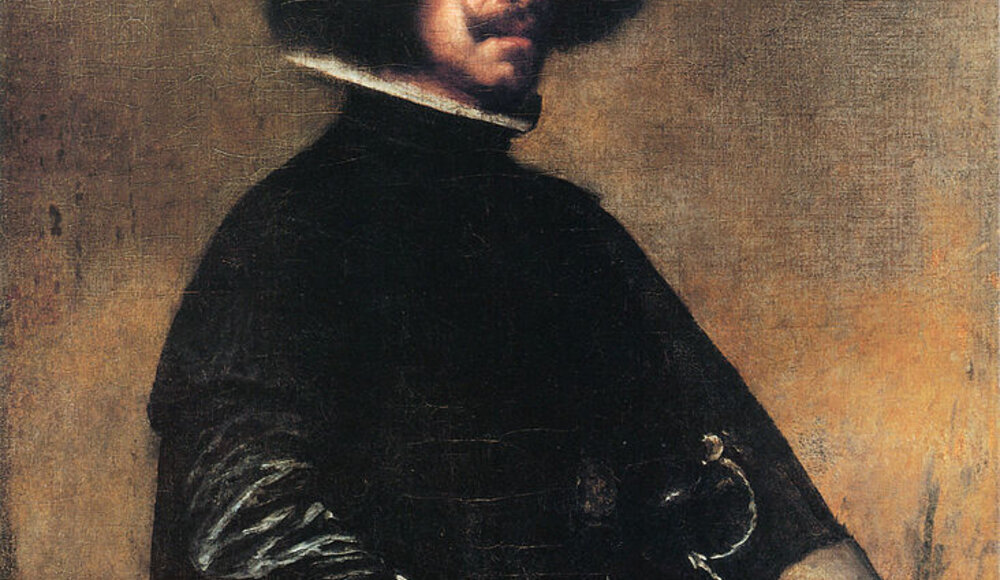
 Selena Mattei
Selena Mattei
